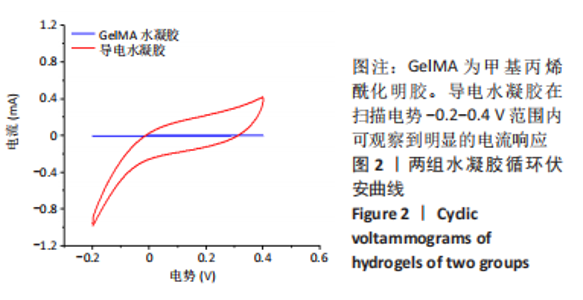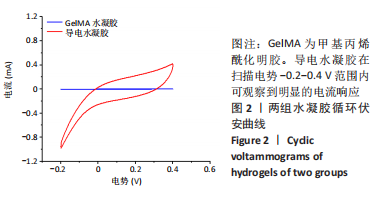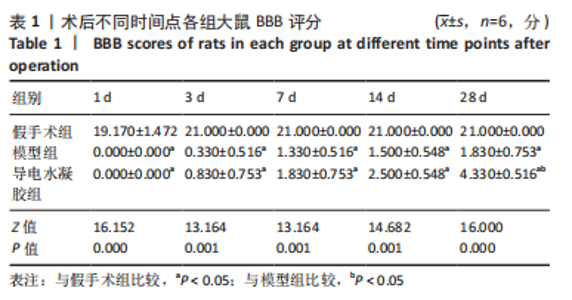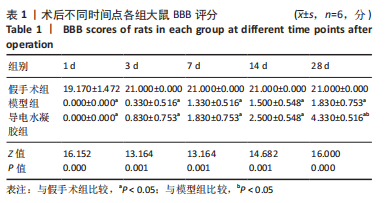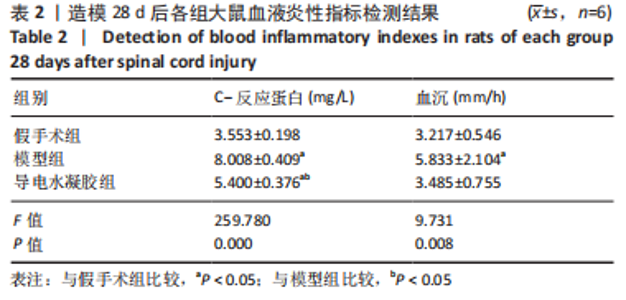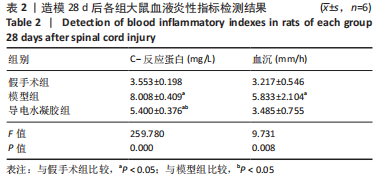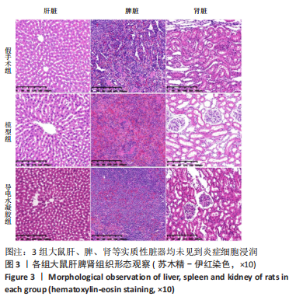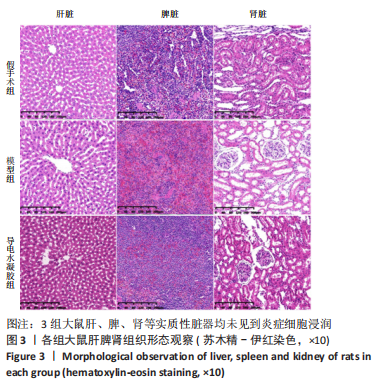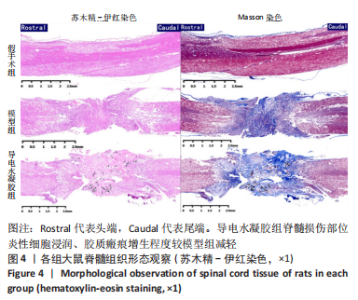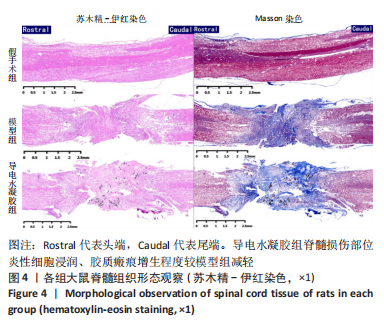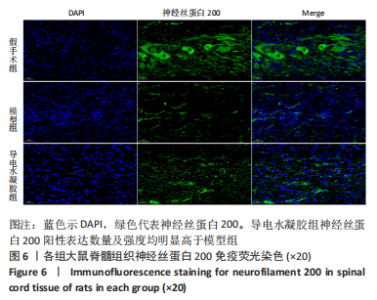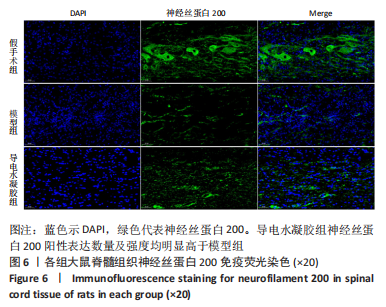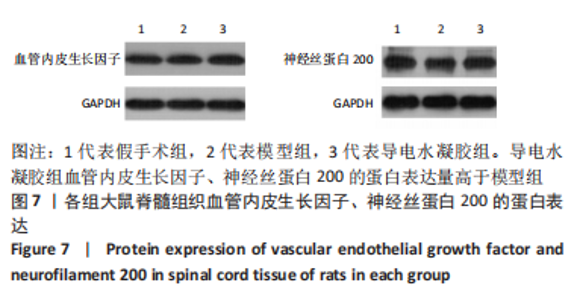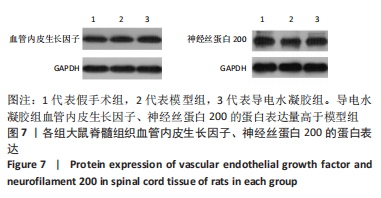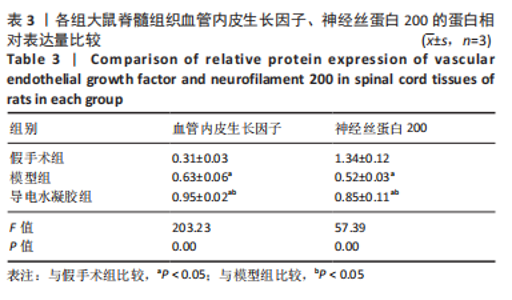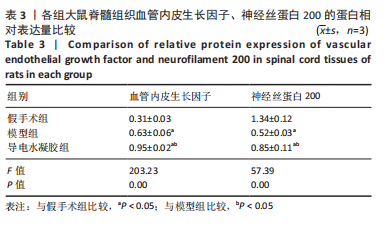Chinese Journal of Tissue Engineering Research ›› 2023, Vol. 27 ›› Issue (21): 3314-3319.doi: 10.12307/2023.454
Previous Articles Next Articles
Safety evaluation of electroactive hydrogel in the treatment of complete spinal cord transection in rats
Jiang Shengyuan1, Deng Bowen1, Liu Gang1, Fan Xiao1, 2, Bai Huizhong1, Tao Jingwei1, Zhao Yi1, Ren Jingpei1, Xu Lin1, Mu Xiaohong1
- 1Dongzhimen Hospital, Beijing University of Chinese Medicine, Beijing 100700, China; 2Qingdao Municipal Hospital, Qingdao 266000, Shandong Province, China
-
Received:2022-05-13Accepted:2022-07-14Online:2023-07-28Published:2022-11-24 -
Contact:Mu Xiaohong, MD, Professor, Chief physician, Doctoral supervisor, Dongzhimen Hospital, Beijing University of Chinese Medicine, Beijing 100700, China Xu Lin, MD, Professor, Chief physician, Dongzhimen Hospital, Beijing University of Chinese Medicine, Beijing 100700, China -
About author:Jiang Shengyuan, Doctoral candidate, Dongzhimen Hospital, Beijing University of Chinese Medicine, Beijing 100700, China -
Supported by:the National Natural Science Foundation of China (General Program), No. 81874467 (to MXH)
CLC Number:
Cite this article
Jiang Shengyuan, Deng Bowen, Liu Gang, Fan Xiao, Bai Huizhong, Tao Jingwei, Zhao Yi, Ren Jingpei, Xu Lin, Mu Xiaohong. Safety evaluation of electroactive hydrogel in the treatment of complete spinal cord transection in rats[J]. Chinese Journal of Tissue Engineering Research, 2023, 27(21): 3314-3319.
share this article
Add to citation manager EndNote|Reference Manager|ProCite|BibTeX|RefWorks
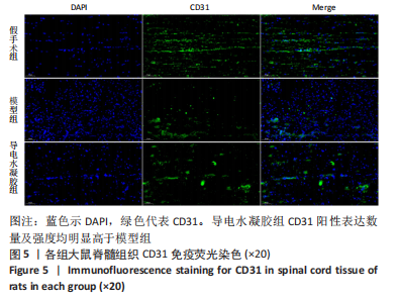
2.5.2 Masson染色 模型组可见脊髓断端处有大量胶原纤维组织生成,无序排列;导电水凝胶组可见导电水凝胶周围出现了部分胶原纤维,排列相对规整,随着水凝胶的降解胶原纤维逐渐长入,导电水凝胶对于胶质瘢痕的增生具有一定的抑制作用,见图4。 2.5.3 免疫荧光染色 镜下观察示,假手术组可见大量CD31阳性血管内皮细胞,且分布均匀,脊髓由于纵切可见条形微血管形态,脊髓组织内有清晰可见的神经纤维和神经元,神经元胞核形态完整;模型组于脊髓断端处仅可见少量散在CD31阳性细胞,无成熟神经元存在;导电水凝胶组CD31阳性血管内皮细胞数量明显多于模型组,且可见成形的微血管,可见少量神经元,细胞核固缩,见图5,6。"
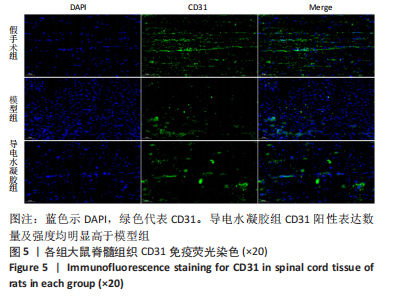
| [1] KOFFLER J, ZHU W, QU X, et al. Biomimetic 3D-printed scaffolds for spinal cord injury repair. Nat Med. 2019;25(2):263-269. [2] KARSY M, HAWRYLUK G. Modern Medical Management of Spinal Cord Injury. Curr Neurol Neurosci Rep. 2019;19(9):65. [3] DUMONT CM, CARLSON MA, MUNSELL MK, et al. Aligned hydrogel tubes guide regeneration following spinal cord injury. Acta Biomater. 2019;86:312-322. [4] ANDERSON MA, O’SHEA TM, BURDA JE, et al. Required growth facilitators propel axon regeneration across complete spinal cord injury. Nature. 2018;561(7723):396-400. [5] 王健豪,刘洋,付玄昊,等.3D打印组织工程支架联合骨髓间充质干细胞移植修复脊髓损伤[J].中华骨科杂志,2021,41(6):376-385. [6] DOMINICI N, KELLER U, VALLERY H, et al. Versatile robotic interface to evaluate, enable and train locomotion and balance after neuromotor disorders. Nat Med. 2012;18(7):1142-1147. [7] BERTUCCI C, KOPPES R, DUMONT C, et al. Neural responses to electrical stimulation in 2D and 3D in vitro environments. Brain Res Bull. 2019;152:265-284. [8] TABATABAEI F, MOHARAMZADEH K, TAYEBI L. Fibroblast encapsulation in gelatin methacryloyl (GelMA) versus collagen hydrogel as substrates for oral mucosa tissue engineering. J Oral Biol Craniofac Res. 2020; 10(4):573-577. [9] GONG H, FEI H, XU Q, et al. 3D-engineered GelMA conduit filled with ECM promotes regeneration of peripheral nerve. J Biomed Mater Res A. 2020;108(3):805-813. [10] CHENG J, CHEN Z, LIU C, et al. Bone mesenchymal stem cell-derived exosome-loaded injectable hydrogel for minimally invasive treatment of spinal cord injury. Nanomedicine (Lond). 2021;16(18):1567-1579. [11] BASSO DM, BEATTIE MS, BRESNAHAN JC. A sensitive and reliable locomotor rating scale for open field testing in rats. J Neurotrauma. 1995;12(1):1-21. [12] SAREMI J, MAHMOODI N, RASOULI M, et al. Advanced approaches to regenerate spinal cord injury: The development of cell and tissue engineering therapy and combinational treatments. Biomed Pharmacother. 2021;146:112529. [13] LUKACOVA N, KISUCKA A, KISS BIMBOVA K, et al. Glial-Neuronal Interactions in Pathogenesis and Treatment of Spinal Cord Injury. Int J Mol Sci. 2021;22(24):13577. [14] DUAN YY, CHAI Y, ZHANG NL, et al. Microtubule Stabilization Promotes Microcirculation Reconstruction After Spinal Cord Injury. J Mol Neurosci. 2021;71(3):583-595. [15] OYINBO CA. Secondary injury mechanisms in traumatic spinal cord injury: a nugget of this multiply cascade. Acta Neurobiol Exp (Wars). 2011;71(2):281-299. [16] WANG Y, LV HQ, CHAO X, et al. Multimodal therapy strategies based on hydrogels for the repair of spinal cord injury. Mil Med Res. 2022; 9(1):16. [17] LI Y, YANG L, HU F, et al. Novel Thermosensitive Hydrogel Promotes Spinal Cord Repair by Regulating Mitochondrial Function. ACS Appl Mater Interfaces. 2022;14(22):25155-25172. [18] PERALE G, ROSSI F, SUNDSTROM E, et al. Hydrogels in spinal cord injury repair strategies. ACS Chem Neurosci. 2011;2(7):336-345. [19] FAN L, LIU C, CHEN X, et al. Directing Induced Pluripotent Stem Cell Derived Neural Stem Cell Fate with a Three-Dimensional Biomimetic Hydrogel for Spinal Cord Injury Repair. ACS Appl Mater Interfaces. 2018;10(21):17742-17755. [20] COURTINE G, GERASIMENKO Y, VAN DEN BRAND R, et al. Transformation of nonfunctional spinal circuits into functional states after the loss of brain input. Nat Neurosci. 2009;12(10):1333-1342. [21] GEREMIA NM, GORDON T, BRUSHART TM, et al. Electrical stimulation promotes sensory neuron regeneration and growth-associated gene expression. Exp Neurol. 2007;205(2):347-359. [22] ZHOU L, FAN L, YI X, et al. Soft Conducting Polymer Hydrogels Cross-Linked and Doped by Tannic Acid for Spinal Cord Injury Repair. ACS Nano. 2018;12(11):10957-10967. [23] LUO Y, FAN L, LIU C, et al. An injectable, self-healing, electroconductive extracellular matrix-based hydrogel for enhancing tissue repair after traumatic spinal cord injury. Bioact Mater. 2021;7:98-111. [24] 刘翔宇,王照东,徐陈,等.载外源性TGF-β_1甲基丙烯酰化明胶复合支架促进颅骨缺损修复实验研究[J].中国修复重建外科杂志, 2021,35(7):904-912. [25] 穆琳,曾今实,黄元亮,等.3D生物打印脂肪来源干细胞联合甲基丙烯酰化明胶构建组织工程软骨的实验研究[J].中国修复重建外科杂志,2021,35(7):896-903. [26] HASSANZADEH P, ATYABI F, DINARVAND R. Tissue engineering: Still facing a long way ahead. J Control Release. 2018;279:181-197. [27] 贺丰,俞兴,穆晓红,等.新型脊髓完全横断缺损模型大鼠的建立[J].中国组织工程研究,2016,20(5):635-639. [28] ALIZADEH A, DYCK SM, KARIMI-ABDOLREZAEE S. Traumatic Spinal Cord Injury: An Overview of Pathophysiology, Models and Acute Injury Mechanisms. Front Neurol. 2019;10:282. [29] ANWAR MA, AL SHEHABI TS, EID AH. Inflammogenesis of Secondary Spinal Cord Injury. Front Cell Neurosci. 2016;10:98. [30] JOSHI HP, KUMAR H, CHOI UY, et al. CORM-2-Solid Lipid Nanoparticles Maintain Integrity of Blood-Spinal Cord Barrier After Spinal Cord Injury in Rats. Mol Neurobiol. 2020;57(6):2671-2689. [31] LI H, KONG R, WAN B, et al. Initiation of PI3K/AKT pathway by IGF-1 decreases spinal cord injury-induced endothelial apoptosis and microvascular damage. Life Sci. 2020;263:118572. |
| [1] | Guo Shuhui, Yang Ye, Jiang Yangyang, Xu Jianwen. Screening and validation of neurogenic bladder miRNA-mRNA regulatory network [J]. Chinese Journal of Tissue Engineering Research, 2023, 27(在线): 1-8. |
| [2] | Yang Jiujie, Li Zhi, Wang Shujie, Tian Ye, Zhao Wei. Intraoperative neurophysiological monitoring of functional changes following durotomy with decompression for acute spinal cord injury [J]. Chinese Journal of Tissue Engineering Research, 2023, 27(8): 1232-1236. |
| [3] | Liu Xiaolin, Mu Xinyue, Ma Ziyu, Liu Shutai, Wang Wenlong, Han Xiaoqian, Dong Zhiheng. Effect of hydrogel-loaded simvastatin microspheres on osteoblast proliferation and differentiation [J]. Chinese Journal of Tissue Engineering Research, 2023, 27(7): 998-1003. |
| [4] | Li Cheng, Zheng Guoshuang, Kuai Xiandong, Yu Weiting. Alginate scaffold in articular cartilage repair [J]. Chinese Journal of Tissue Engineering Research, 2023, 27(7): 1080-1088. |
| [5] | Xu Yan, Li Ping, Lai Chunhua, Zhu Peijun, Yang Shuo, Xu Shulan. Piezoelectric materials for vascularized bone regeneration [J]. Chinese Journal of Tissue Engineering Research, 2023, 27(7): 1126-1132. |
| [6] | Hao Liufang, Duan Hongmei, Wang Zijue, Hao Fei, Hao Peng, Zhao Wen, Gao Yudan, Yang Zhaoyang, Li Xiaoguang. Spatiotemporal dynamic changes of ependymal cells after spinal cord injury in transgenic mice [J]. Chinese Journal of Tissue Engineering Research, 2023, 27(6): 883-889. |
| [7] | Li Xiaoyin, Yang Xiaoqing, Chen Shulian, Li Zhengchao, Wang Ziqi, Song Zhen, Zhu Daren, Chen Xuyi. Collagen/silk fibroin scaffold combined with neural stem cells in the treatment of traumatic spinal cord injury [J]. Chinese Journal of Tissue Engineering Research, 2023, 27(6): 890-896. |
| [8] | Zhang Qijian, Xu Ximing. Acquisition and application of ectodermal mesenchymal stem cells [J]. Chinese Journal of Tissue Engineering Research, 2023, 27(6): 928-934. |
| [9] | Yuan Bo, Xie Lide, Fu Xiumei. Schwann cell-derived exosomes promote the repair and regeneration of injured peripheral nerves [J]. Chinese Journal of Tissue Engineering Research, 2023, 27(6): 935-940. |
| [10] | Li Zhichao, Tan Guoqing, Su Hui, Xu Zhanwang, Xue Haipeng. Regulatory role of non-coding RNAs as potential therapeutic targets in spinal cord injury [J]. Chinese Journal of Tissue Engineering Research, 2023, 27(5): 758-764. |
| [11] | Tao Xin, Xu Yi, Song Zhiwen, Liu Jinbo. Hippo signaling pathway in the regulation of spinal cord injury [J]. Chinese Journal of Tissue Engineering Research, 2023, 27(4): 619-625. |
| [12] | Li Yue, Lyu Yan, Feng Wanying, Song Yang, Yan Yu, Guan Yongge. Preparation of hyperoside nanoparticles to repair endometrial injury [J]. Chinese Journal of Tissue Engineering Research, 2023, 27(3): 360-366. |
| [13] | Chen Bohao, He Qi, Yang Junzheng, Pan Zhaofeng, Xiao Jiacong, Li Miao, Li Shaocong, Zeng Jiaxu, Wang Haibin, Zheng Jia, Zhang Meng. Significance of Piezo1 protein in the pathogenesis of osteonecrosis of femoral head [J]. Chinese Journal of Tissue Engineering Research, 2023, 27(27): 4414-4420. |
| [14] | Fan Xiao, Tao Jingwei, Jiang Shengyuan, Deng Bowen, Mu Xiaohong. Effect of tetramethylpyrazine on iron metabolism after spinal cord injury in rats [J]. Chinese Journal of Tissue Engineering Research, 2023, 27(22): 3561-3566. |
| [15] | Zhao Jinlong, Liu Jichao, Yu Yang. Promoting angiogenesis of platelet-derived growth factor BB modified polycaprolactone and beta-tricalcium phosphate composite scaffolds [J]. Chinese Journal of Tissue Engineering Research, 2023, 27(21): 3300-3306. |
| Viewed | ||||||
|
Full text |
|
|||||
|
Abstract |
|
|||||
